Bechamel sauce is a milk sauce flavored with onion and herbs, and then thickened with a roux. Thanks to its color, it is also often referred to as white sauce.
Commonly used to make cheese sauces for pasta, (notably Alfredo sauce), bechamel sauce is traditionally used to make lasagna, potato gratin and scallop potatoes, as well as Mac & Cheese.
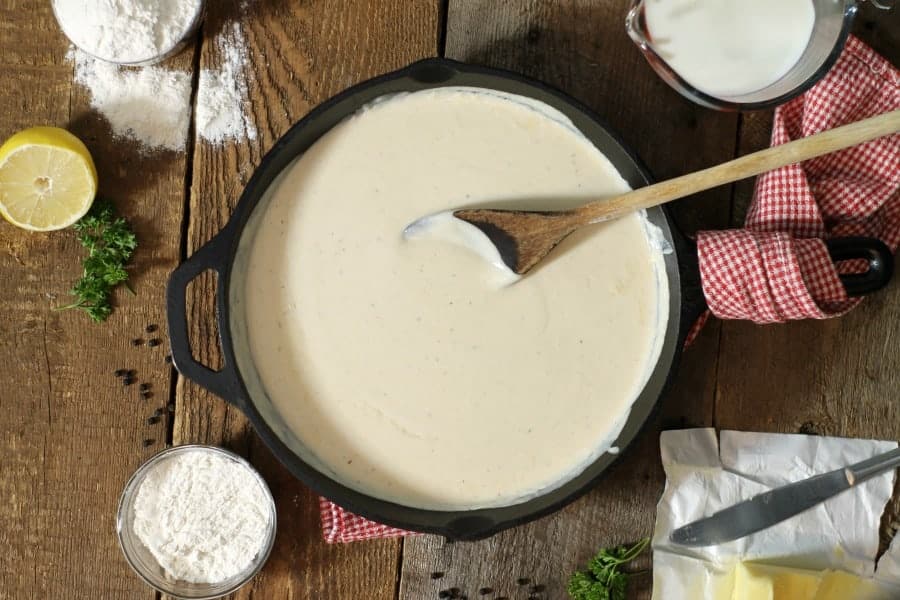
Bechamel Sauce is also one of the five mother sauces, or leading sauces in French cuisine, the base sauces from which many other great sauce varieties are derived.
This post is part of the basic cooking skills series, which includes learning to cook the five mother sauces of French cuisine at home: Béchamel sauce, Velouté sauce, Espagnole sauce, Tomato sauce, and Hollandaise sauce.
What Is Bechamel Sauce?
Bechamel sauce is traditionally made by simmering milk with a clove-studded onion, a bouquet garni (a bundle of herbs), and then thickened with a roux.
Bechamel sauce, when made properly, is a beautiful thing. Velvety smooth, rich, and full of flavor, this sauce forms a great base from which your imagination can create a wide range of flavors.
One of the first mentions of a béchamel-style sauce attributes its origin to Italy, but it was Auguste Escoffier who formally classified it as one of the leading sauces, thereby cementing its place in French cuisine.
As mentioned above, béchamel is most often used to create cheesy pasta sauces, but it can also be paired equally well with seafood or roast chicken to create a more elegant meal.
While velouté sauce and bechamel sauce are both cream-style sauces thickened with a roux, bechamel differs from velouté in that it uses milk as a base, whereas velouté uses a broth or stock.
How To Make Bechamel Sauce
Bechamel is one of the easiest Mother Sauces to master. Hollandaise is arguably the hardest. The great thing about bechamel is that since it's only made with a few simple ingredients, you can easily make a batch of this sauce and keep it refrigerated for a few days, using and flavoring it as needed.
Since this sauce is thickened with a roux, I would caution against freezing it. While possible, the sauce will "split" as it thaws, leaving chunky granular bits behind that need to be re-emulsified before using. This could be done with a blender or other mixing apparatus, but it adds an extra step that can be easily avoided.
Ingredients For Bechamel Sauce
To make this white sauce from scratch you'll need a few basic ingredients. Note that the milk is first simmered with the base ingredients to flavor it, is then thickened with a white roux, and then seasoned with various seasonings.
Bechamel Sauce Base
- 1 liter milk
- 1 medium-sized onion, diced large
- 1 pinch cloves
- 4-5 black peppercorns
- 1 bay leaf
White Roux
- 62 grams of flour (for the roux)
- 62 grams of melted butter (for the roux)
Optional Seasonings
- 1 pinch ground nutmeg
- salt
- fresh lemon - optional
Instructions: How To Cook Bechamel Sauce
- Begin by heating the milk over low heat in a heavy-bottomed sauce pot. Don't just use a cheap pot with a thin base, as the milk will burn easily, ruining your sauce.
- Roughly chop the onion into large dice (this makes it easier to remove later), and add it to the milk along with the bay leaf, peppercorns, and cloves. Simmer gently for ten to fifteen minutes in the milk to infuse the flavors.

- While the milk is simmering, measure out the ingredients for the roux, and then melt the butter in a separate pot. Add the flour with a whisk, making a white roux. To learn why butter and flour are measured by weight, rather than using measuring cups, read this guide to using and making roux.
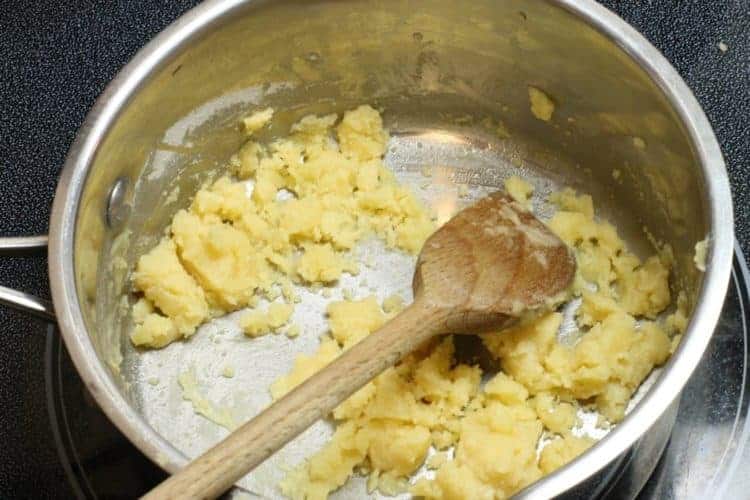
- Strain the onion and bay leaf from the milk, and pour some of the hot milk into the roux. Whisk the mixture as you pour in the milk to avoid lumps. Pour the liquid roux back into the milk mixture. Lightly stir the sauce to properly incorporate the roux as the milk continues to simmer over low heat.
Chef's Note: By first adding liquid to the roux and then combining that mixture with the rest of the milk, you avoid the risk of clumping. It is the easiest way to get a 100% smooth sauce.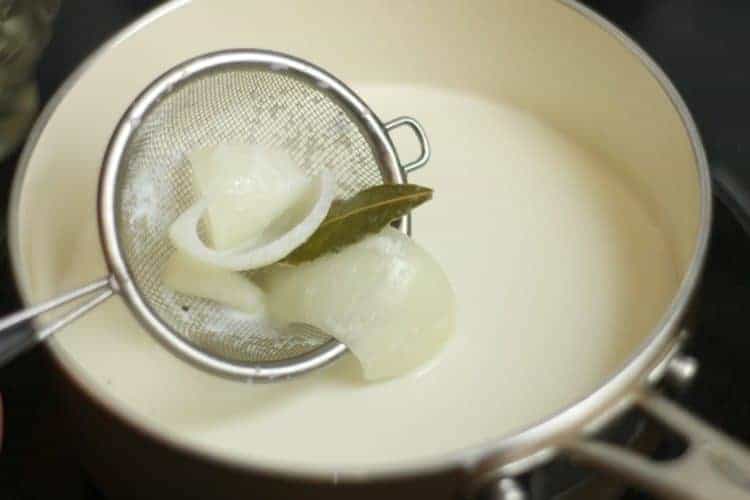
- Continue to cook the bechamel for 15 to 20 minutes over medium-low heat to fully cook out the flour. If you do not cook out the flour, you will be left with a grainy mouth feel and not a silky smooth texture. Try tasting the sauce right after adding the roux, and then again once the flour has cooked out. You will notice a big difference.
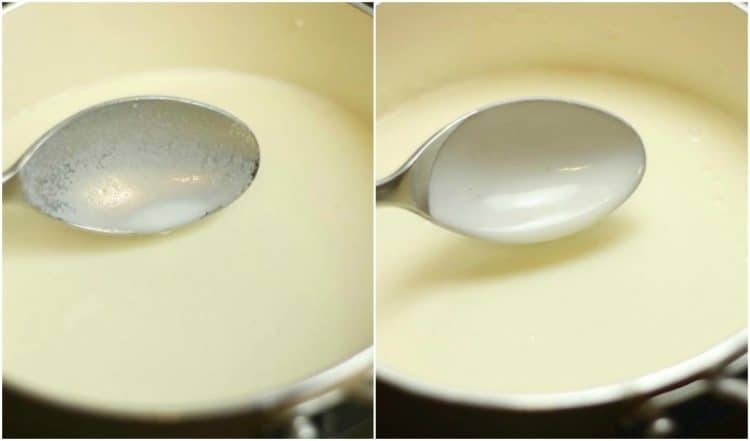
- Stir the bechamel periodically as the sauce slowly cooks, to ensure it does not burn to the bottom of the pot. If you do notice the sauce starting to burn or stick, (brown bits start appearing in the sauce) or you can feel the spoon/whisk scraping along the bottom, immediately strain the sauce into a new pot to avoid ruining the bechamel, and continue over a lower heat setting.
- Finish the bechamel sauce by seasoning it with ½ teaspoon of nutmeg. Add salt and pepper to taste. You can add a squeeze of lemon to the sauce if you like to add a little extra depth of flavor, though this is not required.
Chef's Tip: If you are cooling the sauce for future use, place a layer of plastic wrap directly on the top of the sauce. This will prevent a "skin" from forming, which would ruin the smooth texture once reheated.
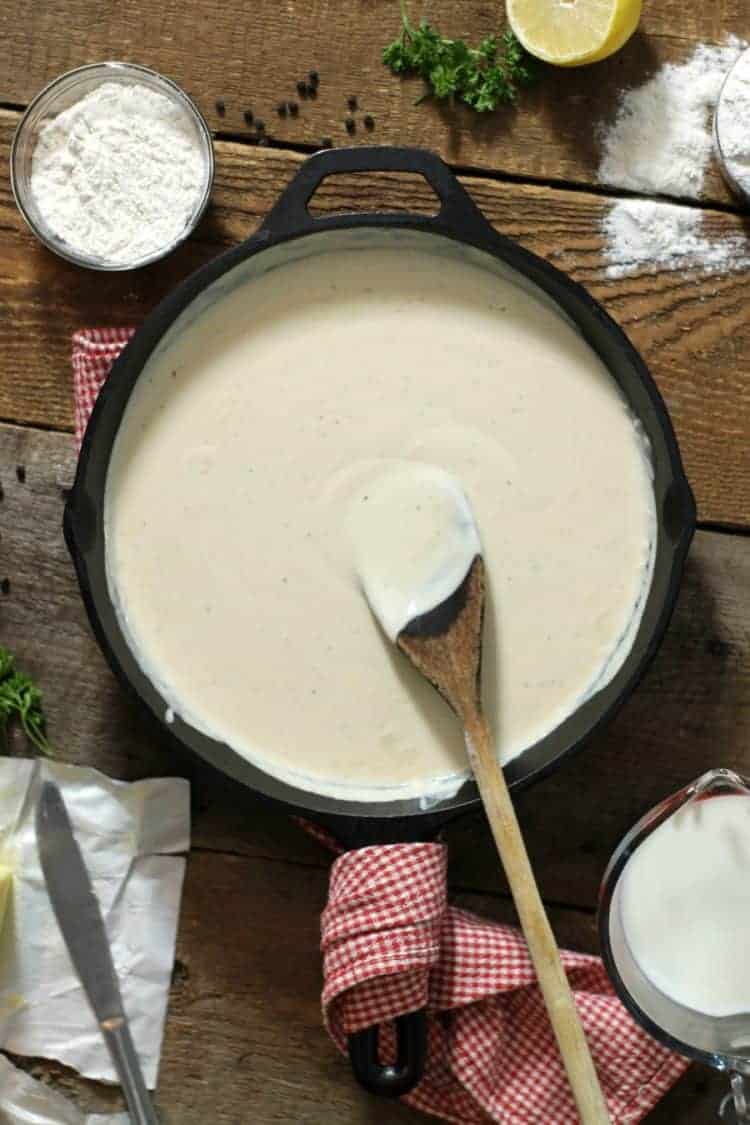
How To Use Bechamel Sauce
Once you have mastered making this simple white sauce at home, it's time to use it in other recipes, of course!
- The easiest recipe to use bechamel in is probably a lasagna or other casserole dish. Once the sauce has been thickened and seasoned, use the white sauce alternately with tomato sauce to layer your lasagna. It can also be used on its own to create a 'white' lasagna without any tomato product.
- Use the bechamel sauce to bind any type of casserole. Simple toss all the vegetables, proteins, etc, in some of the bechamel to bind all the ingredients together, and then bake the mixture in a casserole dish topped with cheese. You can easily make Mac & Cheese this way by first melting shredded cheddar cheese into the bechamel, then adding in cooked macaroni noodles, and baking it in the oven.
- Scalloped Potatoes can be made by slicing and cooking potatoes, then adding garlic powder, julienne onion, and Parmesan along with the bechamel sauce to a casserole dish before baking.
- You can also turn the bechamel sauce into an elegant Mornay Sauce. Melt any sharp cheddar or other hard cheese into the white sauce while whisking to create a cheesy cream sauce perfect for serving with fried fish or other seafood, roast chicken, or any number of vegetable dishes.
Other Béchamel Sauce Derivatives
As one of the mother sauces, Béchamel sauce serves as a foundational base for other well-known French cuisine sauces. Try these variations to experiment with more flavors for your dishes:
- Soubis Sauce: Sautée diced blanched onion in butter and add it to the bechamel along with scalded cream and a little sugar. The soubis is simmered until the onion is fully cooked and then strained. Soubis is often served with meats, game, poultry, or vegetables.
- Cheddar Sauce: Melt grated cheddar cheese into the bechamel, and then season with Tabasco and dry mustard. Popular over broccoli, or other vegetables, as well as a dipping sauce for corn chips.
- Nantau Sauce: Add heavy cream and crayfish butter before seasoning with paprika to achieve a reddish colour. Best served with shellfish, crayfish, or lobster, or other fish and seafood.
- Anchovy Sauce: Add anchovy puree or paste to the bechamel until you get the desired taste. Anchovy sauce pairs well with lightly cooked vegetables or is drizzled over salads.
Tried the recipe? Comment & Rate below, then take a picture and tag me on Facebook & Instagram: @earthfoodandfire . For more from scratch recipes follow me on Instagram & Pinterest!
Recipe
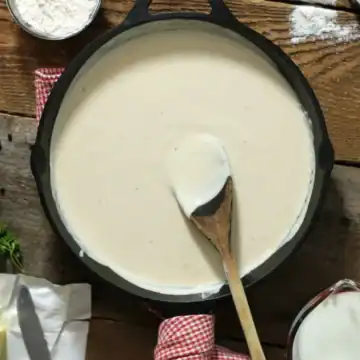
Bechamel Sauce (White Sauce)
Ingredients
Bechamel Sauce Base
- 1 L Milk
- 1 medium Spanish onion diced large
- 1 pinch cloves
- 4-5 whole peppercorns
- 1 individual bay leaf
White Roux
- 62 grams All purpose flour for the roux
- 62 grams Melted butter for the roux
Optional Seasonings
- 1 pinch salt
- 1 pinch ground nutmeg
- 1 squeeze Fresh Lemon Juice
Instructions
- Begin by heating the milk over low heat in a heavy-bottomed sauce pot.
- Chop the onion into a rough large dice and add it to the milk along with the bay leaf, peppercorn, and cloves. Simmer gently for ten to fifteen minutes in the milk to infuse the flavors.
- Melt the butter in a separate pot, and then add the flour with a whisk making a white roux.
- Strain the onion and bay leaf, cloves and peppercorns from the milk. Pour some of the hot milk into the roux. Make sure to whisk the mixture as you pour in the milk to avoid lumps. Pour the liquid-y roux back into the milk mixture. Lightly stir the sauce to properly incorporate the roux as the milk continues to heat over low.
- Over medium low heat, continue to cook the bechamel for 15 to 20 minutes to fully cook out the flour. Stir periodically with a whisk to prevent the bechamel sauce from burning as it thickens.
- Finish the bechamel sauce by seasoning it with ½ teaspoon of nutmeg and salt and pepper to taste. You can add a squeeze of lemon to the sauce if you like to add a little extra depth of flavor though this is not required.
- Use the white sauce hot as is in any recipe calling for cream sauce, or add various flavorings to it such as cheddar cheese or herbs to create a sauce for use with any number of dishes. (Mac & Cheese anyone!?)
Notes
Nutrition
Nutrition info is auto-generated. This information is an estimate; if you are on a special diet, please use your own calculations.

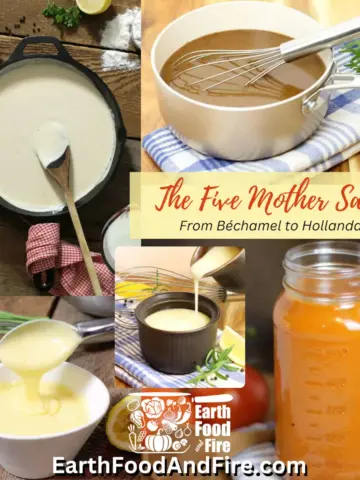
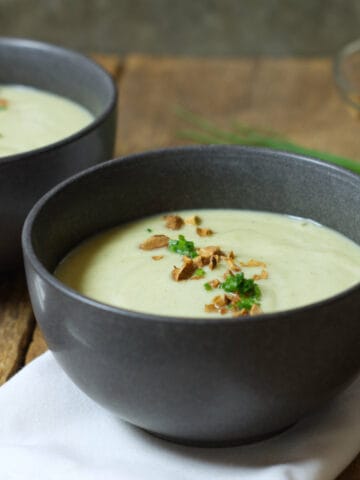
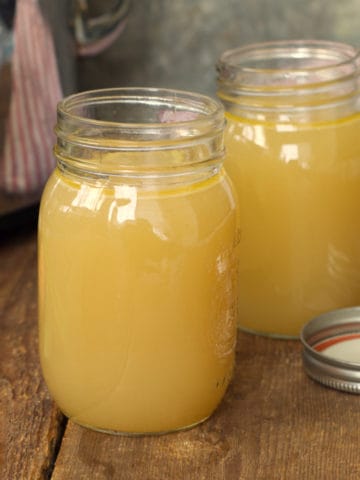
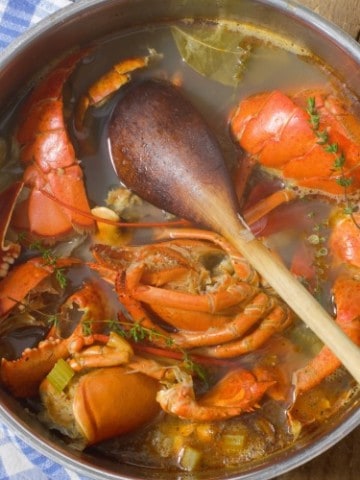
Suzie Q
Dont know the measurements as you used grams and I measure by tsp and cup.
Markus Mueller
Hi Suzi, sorry to hear you're having trouble. The reason I used grams for the flour and butter section of the recipe is that, for a classic bechamel (which this recipe is), a roux is used to thicken it.
The measurements required to make a roux need to be a weight measurement and not a volume measurement (such as tablespoon or cups for example)to properly work. This is because 1 cup of flour and 1 cup of butter (as an example) are not actually equal in weight as they each have different weights per gram/oz. If you prefer using ounces. The 62 grams referenced in the recipe equals to 2.2 oz.
I hope this helps!
Chef Markus
Mardi (eat. live. travel. write.)
Yeah béchamel! I love this sauce - it appears a few times in recipes in my book and my testers were all so thrilled when they realised they were making béchamel (sounds fancy!).
Dana
Heck yes to bechamel! My homemade mac + cheese is the delicacy it is within our group of friends/family because I use bechamel. I think it's under-appreciated; it does so many great things. Perhaps it's a little forgotten due to the fact that everyone is taking shortcuts these days? So, I'm really glad you made this post. Really digging this series!
Cristina @ I Say Nomato
There is nothing like fresh bechamel sauce on pasta - in lasagna... mmmm heaven. I love how you really explain it here, and am excited to see the other sauces you cover